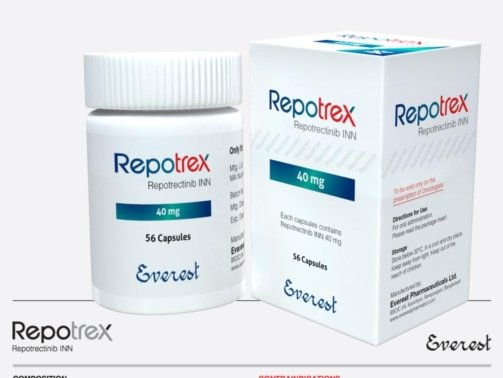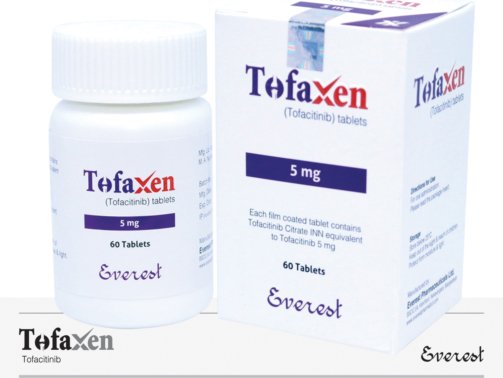Larotrectinib 100 mg (Vitrakvi)
0.00$
Tractoni (Larotrectinib) 100 mg is a medication used in the treatment of solid tumors with neurotrophic tyrosine receptor kinase (NTRK) gene fusion. It belongs to a class of drugs known as tyrosine kinase inhibitors, which work by selectively inhibiting the activity of tropomyosin receptor kinase (TRK) proteins encoded by NTRK genes. Tractoni 100 mg offers a targeted therapy option for patients with NTRK fusion-positive cancers, helping to inhibit tumor growth and improve treatment outcomes.
Larotrectinib, also known as Vitrakvi, is a novel oral drug created to treat solid tumors that have a neurotrophic receptor tyrosine kinase (NTRK) gene fusions. This specific treatment, which comes in the form of a 100 mg capsule, was approved by the U.S. Food and Drug Administration (FDA) in 2018 as the first-of-its-kind therapy based on a common genetic mutation rather than where in the body the tumor lies in. It is manufactured by Bayer in collaboration with Loxo Oncology.
Mechanism of Action
Larotrectinib is a selective TRK inhibitor. TRK proteins, encoded by the NTRK1, NTRK2, and NTRK3 genes, are involved in nervous system development and maintenance. But when there is a chromosomal rearrangement that fuses a gene with NTRK, it forms a chimeric TRK fusion protein with constitutive kinase activity. This aberrant protein stimulates unlimited cell growth and proliferation, causing tumor development.
Larotrectinib selectively inhibits the binding to and activity of TRK fusion protein kinase, preventing the downstream signaling cascades (e.g., MAPK and PI3K-AKT) that result in tumor cell growth and survival. Because it is so selectively active, larotrectinib minimizes off-target activities and maximizes safety and tolerability compared with less selective kinase inhibitors.
Indications
Larotrectinib is indicated for use in the treatment of:
Adult and pediatric patients with a solid tumor that contains an NTRK gene fusion, of any histology, and:
Have no known acquired resistance mutation.
Are metastatic or where surgical resection is highly likely to result in severe morbidity.
Have no suitable alternative therapy available or have progressed following treatment.
It is a tumor-agnostic therapy, which means that larotrectinib can be used in cancer cases such as salivary gland cancer, thyroid cancer, sarcomas, lung cancer, colon cancer, and infantile fibrosarcoma pediatric cancers as long as they have an NTRK fusion.
Dosage and Administration
The dose of Larotrectinib in the typical adult dose is 100 mg twice a day, administered orally with or without food. Pediatric dosing is weight based and can involve oral solution form. Whole capsules should be swallowed and administered consistently to ensure stable levels of the drug in the body.
Dose decrease is feasible in hepatically compromised individuals or in the case of toxicity such as hepatotoxicity or neurotoxicity.
Clinical Efficacy
Larotrectinib has demonstrated impressive activity in early-stage clinical trials, with ORR rates over 75% in a broad spectrum of tumor types. Responses tended to be long-lasting, with most patients demonstrating disease control for many months. Both pediatric and adult patients benefited from treatment, and most noted a considerable improvement in quality of life.
Clinical effectiveness of larotrectinib has transformed precision oncology, confirming the utility of molecular profiling as a diagnostic and therapeutic tool in cancer.
Safety and Side Effects
Larotrectinib is well tolerated. The most common side effects (≥20% of patients) reported are:
Fatigue
Dizziness
Nausea
Elevated liver enzymes (AST, ALT)
Cough
Constipation
Severe but rare side effects may include neurological toxicity, hepatotoxicity, or anemia. Liver function tests should be periodically monitored. The patient must report the practitioner at once if there are any signs of confusion, clumsiness, or jaundice.
Precautions and Interactions
Pregnancy and lactation: Larotrectinib may cause fetal harm and is contraindicated in pregnancy or breastfeeding.
Drug interactions: Because larotrectinib is primarily metabolized by CYP3A4, medications that significantly inhibit or induce this enzyme can alter drug levels. Concurrent use should be avoided or monitored closely with such medications.
Conclusion
Larotrectinib 100 mg (Vitrakvi) is a new approach in treating cancer by targeting tumors based on a genetic mutation rather than location. It is an effective, safe, and well-tolerated therapy for NTRK fusion-positive tumors in children and adults. Its arrival is a shift towards personalized medicine, where drugs are matched with the unique genetic profile of each patient’s cancer.
Order Now At Mdx Pharma bd….
To order from MDX Pharma BD, visit their website at https://mdxpharmabd.com, where you can browse products and place orders online. For inquiries or orders via email, contact emedicarepharma@gmail.com. Alternatively, call (+88) 01929123476. Their address is 29, Abdullahpur, Uttara, Dhaka-1230, Bangladesh.
1. What is the purpose of the medication larotrectinib?
Larotrectinib is used to treat solid tumors (cancer) that are caused by specific faulty NTRK genes and have spread, or if there is no appropriate therapy alternative or the cancer grew or spread on other treatments, or if surgery to remove the disease is likely to cause serious consequences.
2. How long can you use medications for immunotherapy?
Two years might be enough for PD-1 inhibitor monotherapy, while a shorter period might be enough for combination treatments or more recent drugs, where there is a higher potential to activate the immune system.
3. Is the blood-brain barrier crossed by larotrectinib?
Moreover, larotrectinib exhibits action against malignancies of the NTRK-positive central nervous system and can successfully pass the blood-brain barrier [122]. 94% of pediatric patients with solid tumors containing NTRK gene fusions responded to larotrectinib in a phase 1 clinical investigation.
4. What class of drug is Vitrakvi?
Vitrakvi belongs to the kinase inhibitors drug class.
5. Is the blood-brain barrier crossed by larotrectinib?
Moreover, larotrectinib exhibits action against malignancies of the NTRK-positive central nervous system and can successfully pass the blood-brain barrier [122]. 94% of pediatric patients with solid tumors containing NTRK gene fusions responded to larotrectinib in a phase 1 clinical investigation.
| Generic Name: | Larotrectinib |
|---|---|
| Theraputic Category: | Anti-Cancer |
| Pack Size: | 30’s |

 Cart is empty
Cart is empty 



